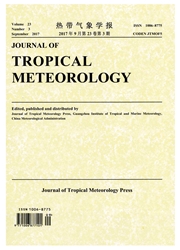

 中文摘要:
中文摘要:
tropospheric 的学习自从 1980 年代,二年的摆动(TBO ) 吸引了重要兴趣。然而,驾驶这进程的机制仍然是不清楚的。在现在的学习, ECMWF 每日的数据被使用评估东方亚洲季风和它的关系的变化到 TBO。首先,一般东方亚洲季风索引(EAMI ) 用 850 hPa u 和 v 部件根据一个选择区域被描出。这个新索引可以描述冬季季风的夏天季风,而且特征的不仅特征,它是关键的理解在夏天和冬季季风之间的转变过程。EAMI 的下列分析证明在夏天和冬季季风之间有一种靠近的关系。一般来说,强壮的东方亚洲冬季季风被强壮的东方亚洲夏天季风跟随,并且弱冬季季风导致弱夏天季风。当强壮时(弱) 夏天季风列在后面由弱(强壮) 冬季季风形成一种 2 年的周期,它可以是在东方亚洲区域上导致 TBO 的可能的机制。
 英文摘要:
英文摘要:
Study of the tropospheric biennial oscillation (TBO) has attracted significant interest since the 1980s. However, the mechanism that drives this process is still unclear. In the present study, ECMWF daily data were applied to evaluate variation of the East Asian monsoon and its relationship to the TBO. First, the general East Asian monsoon index (EAMI) was delineated on the basis of a selected area using the 850 hPa u and v components. This new index may describe not only the characteristics of summer monsoons, but also the features of winter monsoons, which is crucial to understand the transition process between summer and winter monsoons. The following analysis of EAMI shows that there is a close relationship between summer and winter monsoons. In general, strong East Asian winter monsoons are followed by strong East Asian summer monsoons, and weak winter monsoons lead to weak summer monsoons. While strong (weak) summer monsoons followed by weak (strong) winter monsoons form a kind of 2-year cycle, which may be the possible mechanism leading to the TBO over the East Asian region.
 同期刊论文项目
同期刊论文项目
 同项目期刊论文
同项目期刊论文
 The Variations of Dominant Convection Modes over Asia, Indian Ocean, and Western Pacific Ocean durin
The Variations of Dominant Convection Modes over Asia, Indian Ocean, and Western Pacific Ocean durin The Signicant Relationship between the Arctic Oscillation (AO) in December and the January Climate o
The Signicant Relationship between the Arctic Oscillation (AO) in December and the January Climate o 期刊信息
期刊信息
